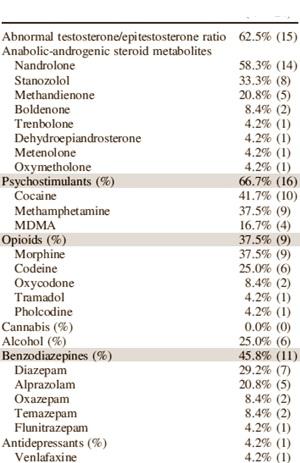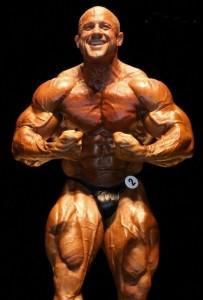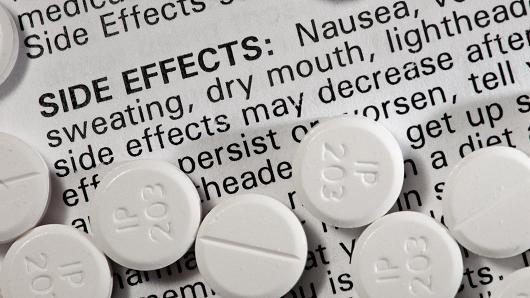Pain Killers and Bodybuilding
While most bodybuilders are dedicated to training, diet and rest, some choose to engage in less healthy activities during the weekends when it’s time to party. Recreational drug use has been attributed to deaths of a few famous bodybuilders including Paul De Mayo and Eric Fromm. Recreational drugs attributed to bodybuilders includes marijuana, crystal meth, ecstasy, GHB, and special-K, amongst others. 
Nubain (nalbuphine hydrochloride) is a synthetic narcotic agonist-antagonist analgesic of the phenanthrene series. It is chemically related to both the widely used narcotic antagonist, naloxone, and the potent narcotic analgesic, oxymorphone. Melvin Anthony talked about his addiction to Nubain in Muscular Development a few years ago. It became very popular with bodybuilders because it allowed them to work past their pain threshold and for some other reasons.
Unfortunately, many people ended up getting addicted to it, and just like other opiates, it is very difficult to come off.... narcotic analgesics tramadol, oxycodone, hydrocodone, OxyContin, morphine, fentanyl.
First let me emphasize that bodybuilders and also professional bodybuilders are just human, abuse of painkillers and anti-anxiety drugs are not unique to bodybuilding. What do you think of painkiller abuse by powerlifters, the NFL and let’s not forget wrestling.
Nubain is no longer available, companies that were producing it discontinued it. At the moment Hospira is the only manufacturer, but according to their website: “Hospira has nalbuphine on shortage due to manufacturing delays and back orders and the company estimates a release date of November 2014”. Because of this the demand for of oxycodone and hydrocodone increased enormously.
Recently there has been a crackdown on physicians and pain clinics. For instance Florida, now has a central prescription database for controlled substances; healthcare providers can log on and see what a patient has been prescribed. This has put an end to the 'doctor shopping', which in turn has decreased the supply available for sale on the street. Cheaper than "doctor shopping" is buying over the internet.
I saw some “to the point posts” in threads on painkillers in the discussion-fora’s:
****”Nubain killed a lot of people indirectly. I've been struggling with opiates on and off for the last year or so ranging from Percocet to sniffing Heroin (the RX opiates are harder to come off than heroin IMO), the withdrawals are far worse than the pain of low carbs and cardio and all that other bullshit. Luckily, I was always able to afford my habit due to good connections and making decent money. I never found myself using them directly for bodybuilding, but they are more bodybuilding-friendly than a lot of other drugs I’ve used with the exception of weed and mild benzo use.”
****”Pain killers are a problem for society as a whole, not just bodybuilders. Having worked in a pharmacy you would see people doctor shop all the time trying to get prescriptions for whatever they could. It’s sad that they develop these addictions, the drug companies are allowed to promote it shamelessly (think if crack were legal and every time you opened a magazine or watched TV there was an advertisement for it) and the doctors enable it by continuing to write the scripts... ”
****”I had a compound fracture of my wrist and was given Morphine and Codeine, I hated this stuff and just lived with the pain!”
****”It really is sickening how freely this shit is prescribed, if someone is abusing Rx opiates it's no different and even worse in many cases that a heroin sniffer and i can make this statement from experience. Then after the docs/pharmacies/pharm companies bleed you dry with the pain meds, they get you hooked again in the form of suboxone or subutex. These are miracle drugs in terms of getting you off the painkillers or dope, but they're just as hard to stop even if you ween off. I've been able to quit for a decent period of time but the rush always finds its way back to me.”
***”Most long time bodybuilders have a steady diet of aspirin, ibuprofen .....especially before going to the gym. At one time I was taking 20-30 buffered aspirin every day. I take 3 Aleve before I go to the gym now. 3 aspirin when I wake up. 3 ibuprofen before I go to sleep.”
****”Heard a lot of stories of bodybuilders going to California and falling into the L.A. syndrome.... hooked on different drugs.... Nubain... Coke... etc... “
Scientific studies
Steroids have been linked to narcotics abuse by scientific research. I think that it’s about time that try to find a link to prescription meds as a gateway to addiction to all kinds of recreational drugs. Besides that, much more people are addicted to prescription drugs.
Interactions between opioids and anabolic androgenic steroids: implications for the development of addictive behavior. Nyberg et all 2012
“….our studies provide evidence that AAS may induce an imbalance in these signal systems leading to an increased sensitivity toward opioid narcotics and central stimulants….”
Past anabolic-androgenic steroid use among men admitted for substance abuse treatment: an underrecognized problem? Kanayama et all 2003
“…Prior AAS use appears to be common but underrecognized among men entering inpatient substance abuse treatment, especially those with opioid dependence. AAS use may serve as a "gateway" to opioid abuse in some cases and may also cause morbidity in its own right….”
Anabolic–Androgenic Steroids as a Gateway to Opioid Dependence Pope et all 2000
“....These findings suggest an alarming trend: that anabolic-androgenic steroids may serve as "gateway" drugs to opioid dependence, with substantial associated morbidity and even mortality….”
Sudden or Unnatural Deaths Involving Anabolic-androgenic Steroids. Darke et all 2014
When steroids users die young and unexpectedly, their death is usually not just the result of having taken muscle-enhancing substances. Only a fraction of steroids users who die young have participated in bodybuilding competitions.
Researchers at the University of New South Wales in Australia summarized the results of 24 post mortems, performed on deceased steroids users. The post mortems took place in Sydney between 1996 and 2012.
All of the deceased were men. Their average age at the time of death was 31. Two-thirds of them were in paid employment. Many of those who died had worked as security agents or earned their money as a personal trainer. A few were still studying. An average steroids deceased is therefore not someone on the edges of society.
In two-thirds of the cases the post mortem showed that the men had died from accidental drug toxicity. In one of every three cases, the death was the result of a fatal combination of steroids and stimulants such as cocaine, amphetamines or XTC. In thirty percent of the cases it was a combination of steroids and opiates that was the cause of death.
In almost all other cases the men had died as a result of crime or suicide.
Ninety percent of the deceased were extremely muscular. "Muscular overdevelopment was present in almost all cases, with half having BMIs in the obese range", the researchers write. "These high BMIs were not due to obesity, but to muscle volume and density."
Of the 24 deceased steroids users 23 were poly-drug users. In addition to their steroids they had also used mainly stimulatory recreational drugs, but also sleeping pills and sedatives, opiates, alcohol and occasionally also antidepressants.
Graig Titus in his column Titus talks:
Recreation drugs and the culture of bodybuilding together like peanut butter and jelly, like Abbott and Costello, like a fag in a dick tree…well you get the picture. There are so many different reasons bodybuilders use recreational drugs other than just to party…and other drugs that aren’t considered recreational.
For example, a drug that’s very prevalent in the culture of bodybuilding is Nubain, or Naluphine. Nubain is a mild injectable pain reliever used either IM or IV. I myself used Naluphine from 1994-2002 off and on depending on its availability. This particular drug is a very effective aid while preparing for contest during severe dieting as well as a excellent pain reliever during and fallowing training sessions.
Nubain does several different things…during extreme dieting it makes you less irritable and definitely takes the edge off. Anyone who’s prepared for a bodybuilding contest knows, sixteen weeks of reduced carbohydrates coupled with the training in general, can turn a calm, cool soul into a son of a bitch…nubain aids in maintaining the calm and cool. It’s a excellent sleep aid prefect for an athlete who’s starving when it’s time to rest. Chris Cormier and myself used Naluphine before and during our training sessions. A injection during heavy training days eliminated lower back pain as well as joint pain in general.
This drug was in the gym bags of so many bodybuilders…Tom Prince, Matt DuVall, Jason Arntz, Cormier, Mike Matarazzo, Jim Quinn, Paul DeMayo, Mike Christian, Dennis Newman, myself…the list is endless and honestly almost every pro bodybuilder I knew used Nubain at one time or another.
Nubain was so prevalent in the bodybuilding and fitness industry its use wasn’t just limited to bodybuilders only So called contest Prep Guru’s used the drug as well…not to mention writers and nutritional company owners and sales reps. The downfall to Nubain use is that it’s highly addictive and extremely hard to stop using. It’s just like any other pain relieve in that it hits your opiate receptors so when you stop injections, the withdrawals are sever and lasts for several days. I stopped using Nubain all together in 2002.
Then of course you have your sleep aids such as Zanax, Valum, ambient and several others. These are extremely popular with bodybuilders who believe because Nubain is injectable that taking pills is in some way more acceptable…giving them the illusion of being less of a junky. Which brings me to pain relievers in general…all pain relievers…you name the pill and I can name 10 bodybuilders who used or use them on a daily basis. You think these bodybuilders who’ve received kidney transplants and or have problems with their liver caused from steroid use? Hell no! Those health issues were a direct result of long term drug abuse, in addition to steroid use. And then you have the recreational drugs, the drugs used specifically for partying…in addition to smoking weed. 
As far as marijuana is concerned, I’m not disclosing any information that isn’t already known. We already posted about that here: //juicedmuscle.com/jmblog/content/marijuana-and-bodybuilder Smoking pot and bodybuilding has been going on since the very beginning. Go ahead and watch “Pumpin’ Iron” and you’ll see it first hand with Arnold enjoying a joint following his competition. Anyway, bodybuilders work out hard, they put themselves through severe dieting schedules and as a result, they play hard And in some cases, the recreational drug use becomes part of their daily life and contest prep…including alcohol. It’s common Knowledge that Kevin Lavrone smelled like a bottle of whiskey pumping up just before going on stage. At both the 2001 and 2002 Olympia’s, I could smell Kevin’s contest prep oozing out of his pores. Rumor was he used alcohol today out ridding himself of sub Q water.
And then you have Chris Cormier and myself. The best ever looked was at the 2001 San Francisco Pro Show Cormier was up all night prior to pre-judging using cocaine and I used it prior to pre-judging the morning of…Chris and I placed 1st and 2nd that day. Not to mention the coke was in addition to a couple injection of Nubain as well. I know some of you are reading this article thinking “oh my God, I can’t believe they did that.” Well believe it, it happens all the time and more often then you could possibly imagine. Crystal Meth for dieting to suppress appetite, cocaine to suppress appetite, and dry skin out for stage, pain relievers to eliminate joint pain, Zanax Valum Ambien to sleep, it’s all being used on a regular basis…for the record, I’ve never used crystal meth for anything. I also want to stay out of fairness to the bodybuilding greats, generally athlete’s placing in the top five in the Olympia or placing in top spots in other shows on a regular basis, probably aren’t using recreational drugs, other than when it’s time to party…or they keep secrets better than others.
And let’s not forget my “Emperor Entertainment” IFBB and NPC After parties!! If there were 10 fitness and bodybuilding celebrities sitting in one section, 9 of them were using ecstasy or special-K or Alcohol or Coke or whatever. So what Role do recreational drugs play in the sport and culture of bodybuilding? Many roles and in some cases-All roles.
************************************************************************************************************
Double Trouble
Adding a benzodiazepine to an opioid painkiller can increase the effect of the opioid, or in the language of addiction, benzos can boost the high ...
Prescription records show that as use of opioids like OxyContin and Vicodin soared in the 2000s, so did the use of "benzos" such as Xanax, Klonopin, and Ativan, as opioid users discovered tranquilizers could enhance "the high."
Data show the drugs are on the upswing again, increasing from 80 million prescriptions in 2006 to 94 million in 2013, according to IMS Health, a drug market research firm.
Now, thousands of Americans are dying each year after mixing opioids and benzodiazepines. The combination turned up in 30% of the 16,651 overdose deaths involving narcotic painkillers in 2010, the most recent year for which data were available, according to the U.S. Centers for Disease Control and Prevention.
Following the Money
The benzodiazepine marketing campaign unfolded against a background of industry influence in medical practice and medical research. For example, a 2006 paper found significant financial ties between drug companies and panel members who produced the DSM-IV. The manuals are put out by the American Psychiatric Association.
Among 170 panel members, 56% had financial links to drug companies, according to the paper.In the field of anxiety disorders, 81% of the panel members had financial connections to drug companies.For the paper, the researchers included any financial affiliations panel members had with the drug industry between the years of 1989 and 2004.
Separately, benzodiazepines are mentioned favorably in a 2009 national practice guideline for treating panic disorder that also was issued by the American Psychiatric Association.
Five of the seven doctors on that panel, including its chairman, worked as speakers or consultants to drug companies that sold benzodiazepines in the 3 years prior to the publishing of the guideline, according to disclosure statements issued with the document. This included work for Pfizer, whose drug Xanax XR, won FDA approval for the condition 3 years earlier, according to disclosure statements issued with the guideline.
On Jun 2014 Chicago filed a lawsuit against five major producers of pharmaceutical products , accusing the group of concealing the risks associated with certain painkillers and seeking to recover nearly $10 million in prescription costs.
Alleging that “drugmakers " should never place its desire for profits above the health and well-being of its customers," the city said that the companies knew for years that certain pain-alleviating drugs were addictive and could prove debilitating in the long-term.
The five companies named in the suit include Actavis, Endo Health Solutions, Janssen Pharmaceuticals —a unit of Johnson & Johnson, Purdue Pharma and Cephalon, a division of generic drug giant Teva.
The lengthy suit, filed in a Cook County circuit court, alleges that the cohort of companies misused their dominance to broaden the market for "opium-like painkillers" called opioids. These prescription drugs included top-shelf brand names such as OxyContin and Percocet, as well as a clutch of generics.
The drug makers "spent millions of dollars funding, assisting and encouraging doctors and front groups" to promote the drugs and broaden their reach among users afflicted with chronic pain, Chicago says. The city seeks to recover at least some of the $9.5 million it paid to fill 400,000 prescriptions for these drugs since 2008, as well as compensatory damages, penalties and legal costs.
The effort to flood the market was "wildly successful. The United States is now awash in opioids," the suit said, citing data showing that more than 250 million prescriptions for the narcotic were filled in 2010 and generating more than $8 billion in revenue during that year. According to figures, the U.S. represents 80 percent of the global opioid market and 99 percent of the world's hydrocodone supply, the city contends.
The suit contends that the drugs have ramped up addiction that has become a scourge in Chicago and other major cities.
Robyn Frenze, a spokesperson for Janssen, said in a statement e-mailed to CNBC that the company "is committed to ethical business practices and responsible promotion, prescribing and use of all our medications. We're currently reviewing the complaint."
Representatives for Actavis and Cephalon said the company does not comment on pending litigation. Representatives for Endo and Purdue were not immediately available to respond to requests from CNBC.
A new report by Visiongain predicts that the world market for drugs to relieve pain will reach $68.0 billion for 2013. Antidepressants are still the most consumed class of medication in the U.S., with 270 million prescriptions per year. But sales revenue has gone down, to $9.4 billion, from a 2008 peak of $12 billion. Lower-priced generics now account for 85% of prescriptions
- Login to post comments


